Non-Steroidal Anti-Inflammatory Drug Effect on the Binding of Plasma Protein with Antibiotic Drug Ceftazidime: Spectroscopic and In Silico Investigation
Abstract
:1. Introduction
2. Results and Discussions
2.1. UV-Visible Absorption Spectroscopy
2.2. Intrinsic Fluorescence
2.3. Analysis of Fluorescence Data
2.4. Estimation of Thermodynamic Parameters
2.5. Far-UV Circular Dichroism Spectroscopy
2.6. Competitive Binding Site Assay
2.7. Effect of Paracetamol on the Binding
2.8. Molecular Docking
2.9. Molecular Dynamics Simulations
3. Materials and Methods
4. Conclusions
Supplementary Materials
Author Contributions
Funding
Institutional Review Board Statement
Informed Consent Statement
Data Availability Statement
Acknowledgments
Conflicts of Interest
References
- Ballante, F. Protein-Ligand Interactions and Drug Design; Springer: New York, NY, USA, 2021. [Google Scholar]
- Vuignier, K.; Schappler, J.; Veuthey, J.-L.; Carrupt, P.-A.; Martel, S. Drug–protein binding: A critical review of analytical tools. Anal. Bioanal. Chem. 2010, 398, 53–66. [Google Scholar] [CrossRef] [PubMed]
- Molino, N.M.; Wang, S.-W. Caged protein nanoparticles for drug delivery. Curr. Opin. Biotech. 2014, 28, 75–82. [Google Scholar] [CrossRef] [PubMed]
- Bidwell, G.; Reese, C.; Shao, Q.M.; Chade, A. A Kidney-targeted Protein Biopolymer Drug Delivery System. Faseb. J. 2015, 29, 967–975. [Google Scholar] [CrossRef]
- Kianfar, E. Protein nanoparticles in drug delivery: Animal protein, plant proteins and protein cages, albumin nanoparticles. J. Nanobiotechnol. 2021, 19, 159. [Google Scholar] [CrossRef]
- Hong, S.; Choi, D.W.; Kim, H.N.; Park, C.G.; Lee, W.; Park, H.H. Protein-Based Nanoparticles as Drug Delivery Systems. Pharmaceutics 2020, 12, 604. [Google Scholar] [CrossRef]
- Scheife, R.T. Protein Binding: What Does it Mean? DICP 1989, 23, S27–S31. [Google Scholar] [CrossRef]
- Alagga, A.A.; Gupta, V. Drug Absorption. In StatPearls; StatPearls Publishing: Treasure Island, FL, USA, 2023. [Google Scholar]
- Aldred, E.M.; Buck, C.; Vall, K. Chapter 16—How do drugs get into cells. In Pharmacology; Aldred, E.M., Buck, C., Vall, K., Eds.; Churchill Livingstone: Edinburgh, UK, 2009; pp. 123–127. [Google Scholar]
- Simmons, P.; Penny, R.; Goller, I. Plasma Proteins a Review. Med. J. Aust. 1969, 2, 494–506. [Google Scholar] [CrossRef]
- Theodore Peters, J. All About Albumin: Biochemistry, Genetics, and Medical Applications; Academic Press: Cambridge, MA, USA, 1995. [Google Scholar]
- Ghuman, J.; Zunszain, P.A.; Petitpas, I.; Bhattacharya, A.A.; Otagiri, M.; Curry, S. Structural basis of the drug-binding specificity of human serum albumin. J. Mol. Biol. 2005, 353, 38–52. [Google Scholar] [CrossRef]
- Fanali, G.; di Masi, A.; Trezza, V.; Marino, M.; Fasano, M.; Ascenzi, P. Human serum albumin: From bench to bedside. Mol. Asp. Med. 2012, 33, 209–290. [Google Scholar] [CrossRef]
- Zvetanka, D.Z. Studies on Drug—Human Serum Albumin Binding: The Current State of the Matter. Curr. Pharm. Des. 2015, 21, 1817–1830. [Google Scholar]
- Pfab, C.; Abgaryan, A.; Danzer, B.; Mourtada, F.; Ali, W.; Gessner, A.; El-Najjar, N. Ceftazidime and cefepime antagonize 5-fluorouracil’s effect in colon cancer cells. BMC Cancer 2022, 22, 125. [Google Scholar] [CrossRef] [PubMed]
- Ali, M.S.; Waseem, M.; Subbarao, N.; Al-Lohedan, H.A. Dynamic interaction between lysozyme and ceftazidime: Experimental and molecular simulation approaches. J. Mol. Liq. 2021, 328, 115412. [Google Scholar] [CrossRef]
- Ali, M.S.; Muthukumaran, J.; Al-Lohedan, H.A. Molecular interactions of ceftazidime with bovine serum albumin: Spectroscopic, molecular docking, and DFT analyses. J. Mol. Liq. 2020, 313, 113490. [Google Scholar] [CrossRef]
- Schmid, F.X. Biological Macromolecules: UV-visible Spectrophotometry. In eLS; Wiley: Hoboken, NJ, USA, 2001. [Google Scholar]
- Ali, M.S.; Al-Lohedan, H.A. Deciphering the interaction of procaine with bovine serum albumin and elucidation of binding site: A multi spectroscopic and molecular docking study. J. Mol. Liq. 2017, 236, 232–240. [Google Scholar] [CrossRef]
- Ali, M.S.; Muthukumaran, J.; Jain, M.; Al-Lohedan, H.A.; Abul Farah, M.; Alsowilem, O.I. Experimental and computational investigation on the binding of anticancer drug gemcitabine with bovine serum albumin. J. Biomol. Struct. Dyn. 2021, 40, 9144–9157. [Google Scholar] [CrossRef] [PubMed]
- Ali, M.S.; Muthukumaran, J.; Jain, M.; Al-Sanea, A.S.S.; Al-Lohedan, H.A. Experimental and in silico investigation on the interaction of indomethacin with bovine serum albumin: Effect of sodium dodecyl sulfate surfactant monomers on the binding. J. Mol. Liq. 2021, 336, 116858. [Google Scholar]
- Ali, M.S.; Rehman, M.T.; Al-Lohedan, H.A.; AlAjmi, M.F. Exploration of the binding between cuminol and bovine serum albumin through spectroscopic, molecular docking and molecular dynamics methods. J. Biomol. Struct. Dyn. 2022, 40, 12404–12412. [Google Scholar] [CrossRef]
- Lakowicz, J.R. Principles of Fluorescence Spectroscopy, 3rd ed.; Springer: New York, NY, USA, 2006; p. 954. [Google Scholar]
- Ali, M.S.; Muthukumaran, J.; Jain, M.; Santos-Silva, T.; Al-Lohedan, H.A.; Al-Shuail, N.S. Molecular interactions of cefoperazone with bovine serum albumin: Extensive experimental and computational investigations. J. Mol. Liq. 2021, 337, 116354. [Google Scholar] [CrossRef]
- Ali, M.S.; Al-Lohedan, H.A. Spectroscopic and computational evaluation on the binding of safranal with human serum albumin: Role of inner filter effect in fluorescence spectral correction. Spectrochim. Acta A 2018, 203, 434–442. [Google Scholar] [CrossRef]
- Stern, O.; Volmer, M. The extinction period of fluorescence. Phys. Z 1919, 20, 183–188. [Google Scholar]
- Jiang, M.; Xie, M.X.; Zheng, D.; Liu, Y.; Li, X.Y.; Chen, X. Spectroscopic studies on the interaction of cinnamic acid and its hydroxyl derivatives with human serum albumin. J. Mol. Struct. 2004, 692, 71–80. [Google Scholar]
- Ali, M.S.; Muthukumaran, J.; Jain, M.; Tariq, M.; Al-Lohedan, H.A.; Al-Sanea, A.S.S. Detailed Experimental and In Silico Investigation of Indomethacin Binding with Human Serum Albumin Considering Primary and Secondary Binding Sites. Molecules 2023, 28, 2979. [Google Scholar] [CrossRef] [PubMed]
- Ali, M.S.; Al-Lohedan, H.A. Experimental and Computational Investigation on the Interaction of Anticancer Drug Gemcitabine with Human Plasma Protein: Effect of Copresence of Ibuprofen on the Binding. Molecules 2022, 27, 1635. [Google Scholar] [CrossRef]
- Ali, M.S.; Rehman, M.T.; Al-Lohedan, H.; AlAjmi, M.F. Spectroscopic and Molecular Docking Investigation on the Interaction of Cumin Components with Plasma Protein: Assessment of the Comparative Interactions of Aldehyde and Alcohol with Human Serum Albumin. Int. J. Mol. Sci. 2022, 23, 4078. [Google Scholar] [CrossRef] [PubMed]
- Ross, P.D.; Subramanian, S. Thermodynamics of protein association reactions: Forces contributing to stability. Biochemistry 1981, 20, 3096–3102. [Google Scholar] [CrossRef]
- Sudlow, G.; Birkett, D.J.; Wade, D.N. The characterization of two specific drug binding sites on human serum albumin. Mol. Pharmacol. 1975, 11, 824–832. [Google Scholar]
- Sudlow, G.; Birkett, D.J.; Wade, D.N. Further Characterization of Specific Drug Binding-Sites on Human-Serum Albumin. Mol. Pharmacol. 1976, 12, 1052–1061. [Google Scholar]
- Zhang, H.X.; Huang, X.; Mei, P.; Li, K.H.; Yan, C.N. Studies on the interaction of tricyclazole with beta-cyclodextrin and human serum albumin by spectroscopy. J. Fluoresc. 2006, 16, 287–294. [Google Scholar] [CrossRef]
- Enna, S.J.; David, B. (Eds.) Robert Roskoski, in Modulation of Enzyme Activity, Bylund, xPharm: The Comprehensive Pharmacology Reference; Elsevier: Amsterdam, The Netherlands, 2007; pp. 1–11. [Google Scholar]
- Morris, G.M.; Huey, R.; Lindstrom, W.; Sanner, M.F.; Belew, R.K.; Goodsell, D.S.; Olson, A.J. AutoDock4 and AutoDockTools4: Automated docking with selective receptor flexibility. J. Comput. Chem. 2009, 30, 2785–2791. [Google Scholar] [CrossRef]
- Van Der Spoel, D.; Lindahl, E.; Hess, B.; Groenhof, G.; Mark, A.E.; Berendsen, H.J.C. GROMACS: Fast, flexible, and free. J. Comput. Chem. 2005, 26, 1701–1718. [Google Scholar] [CrossRef]
- Zoete, V.; Cuendet, M.A.; Grosdidier, A.; Michielin, O. SwissParam: A fast force field generation tool for small organic molecules. J. Comput. Chem. 2011, 32, 2359–2368. [Google Scholar] [CrossRef] [PubMed]
- Kumari, R.; Kumar, R.; Lynn, A. g_mmpbsa—A GROMACS Tool for High-Throughput MM-PBSA Calculations. J. Chem. Inf. Model. 2017, 54, 1951–1962. [Google Scholar] [CrossRef] [PubMed]
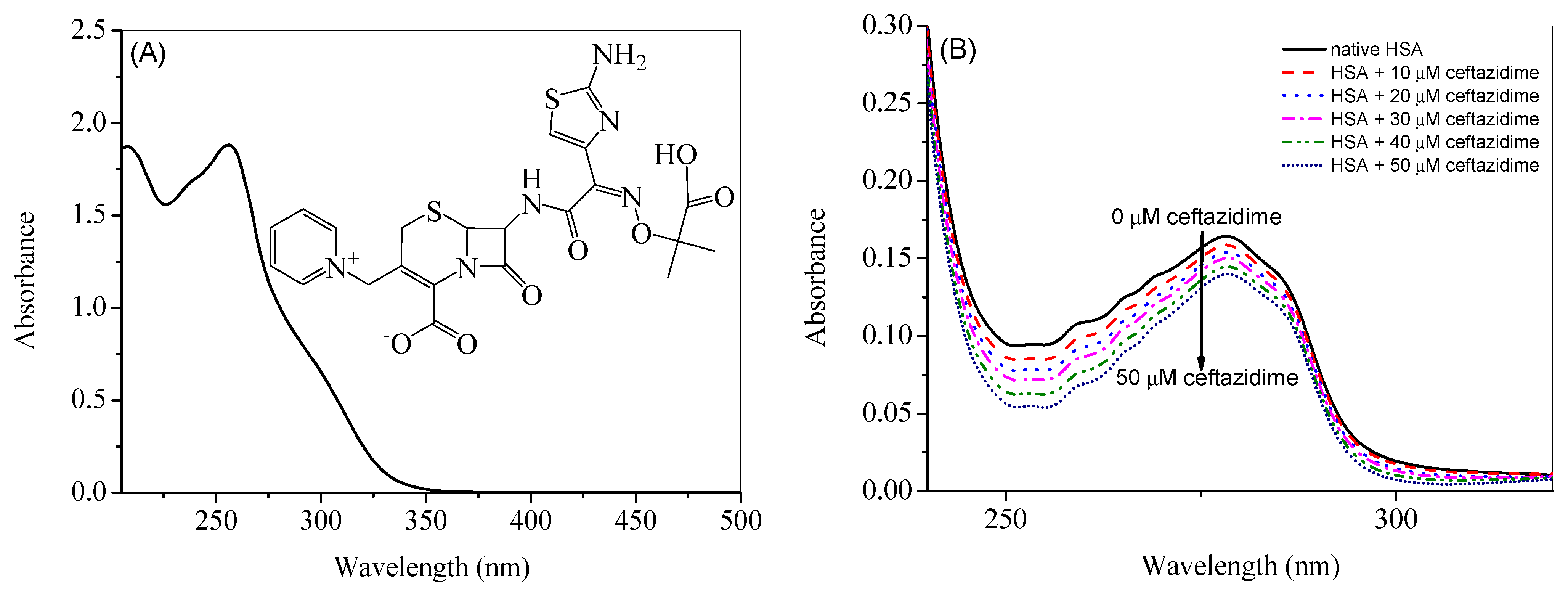
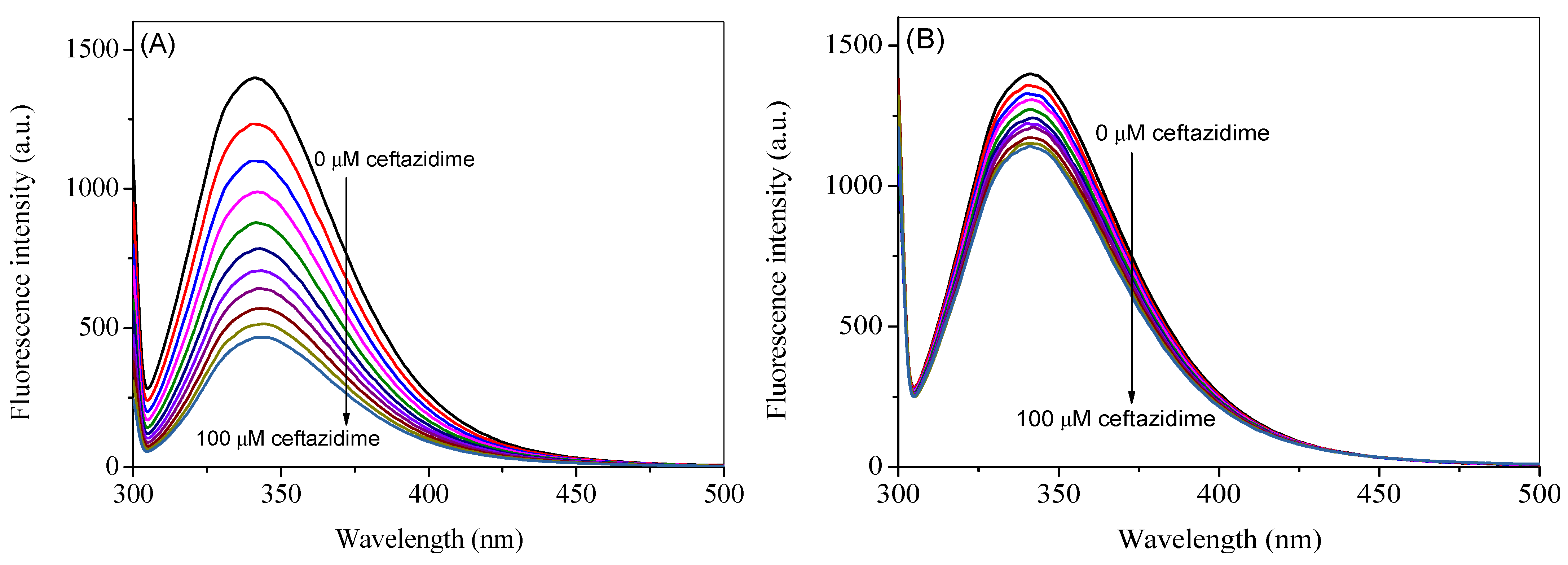

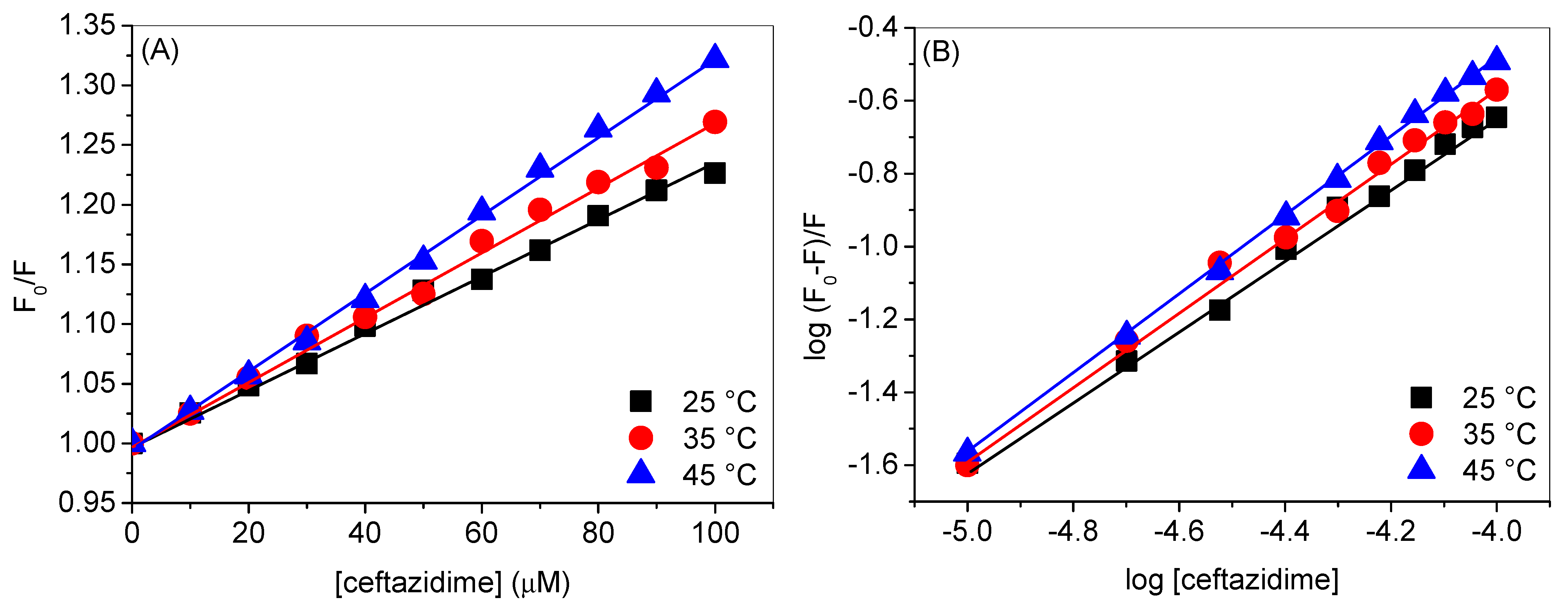
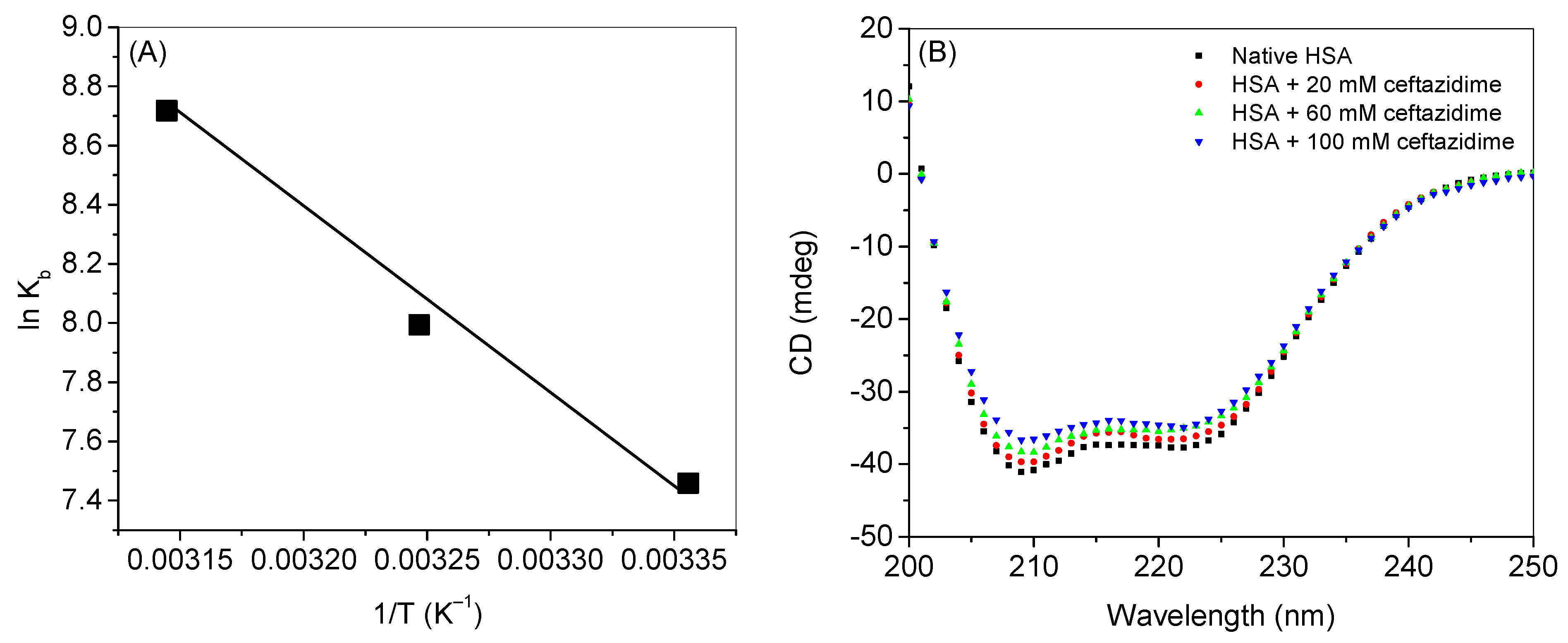

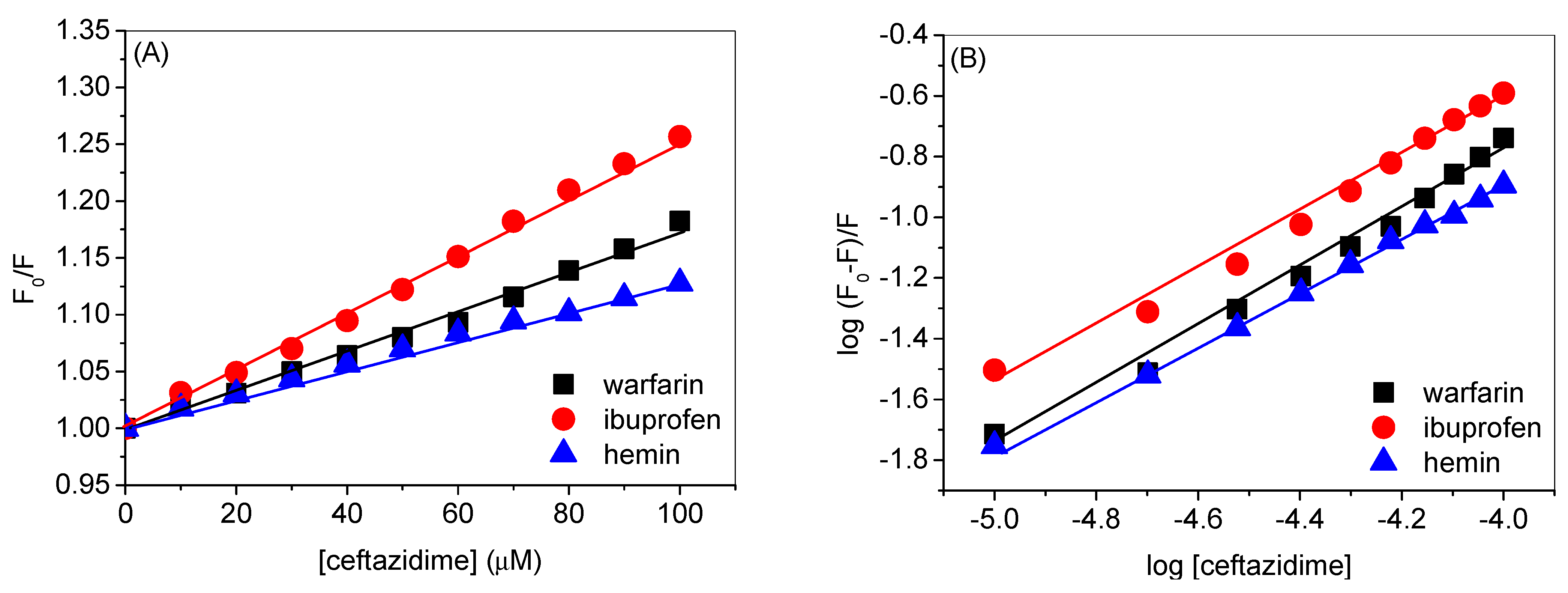

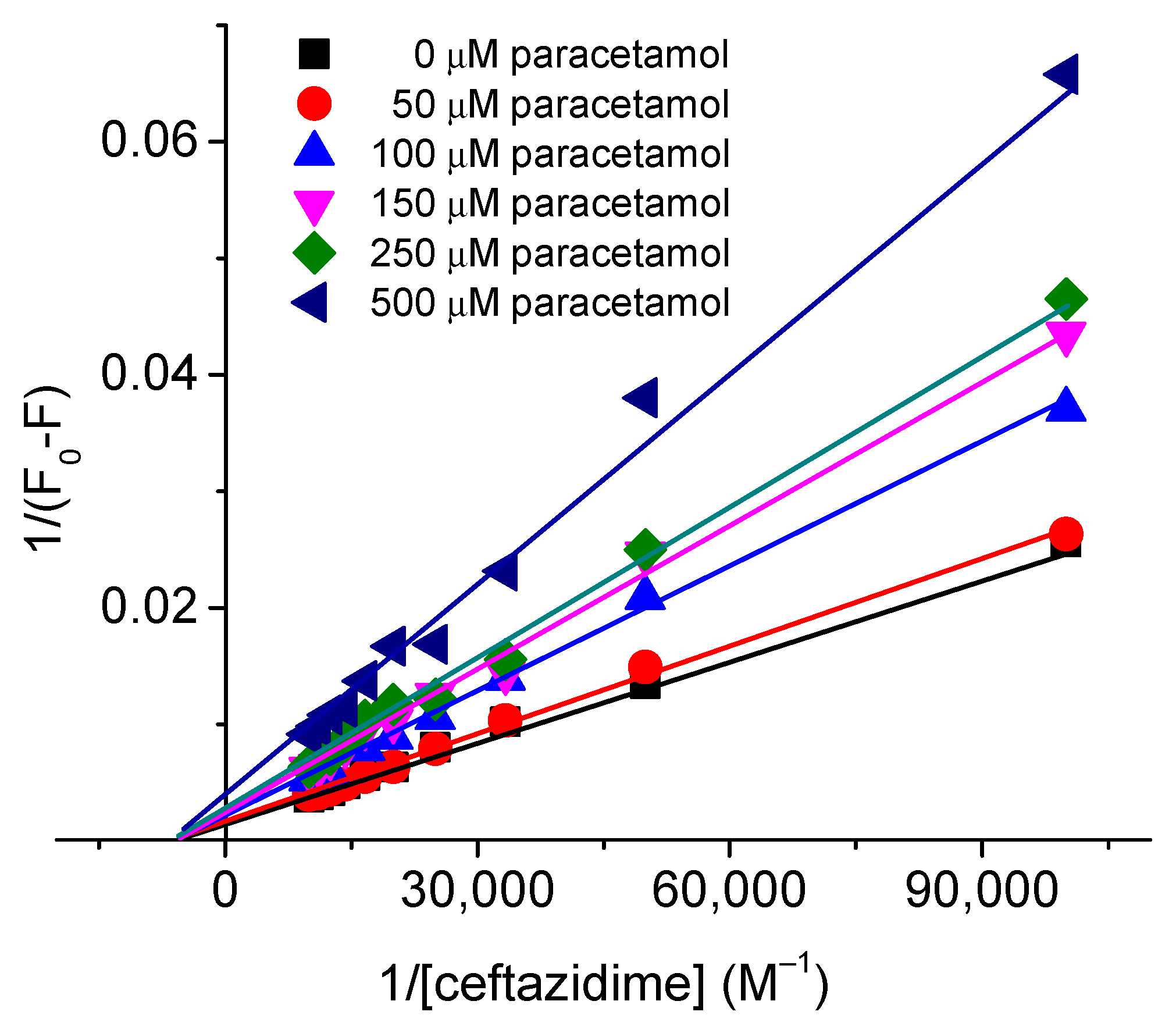
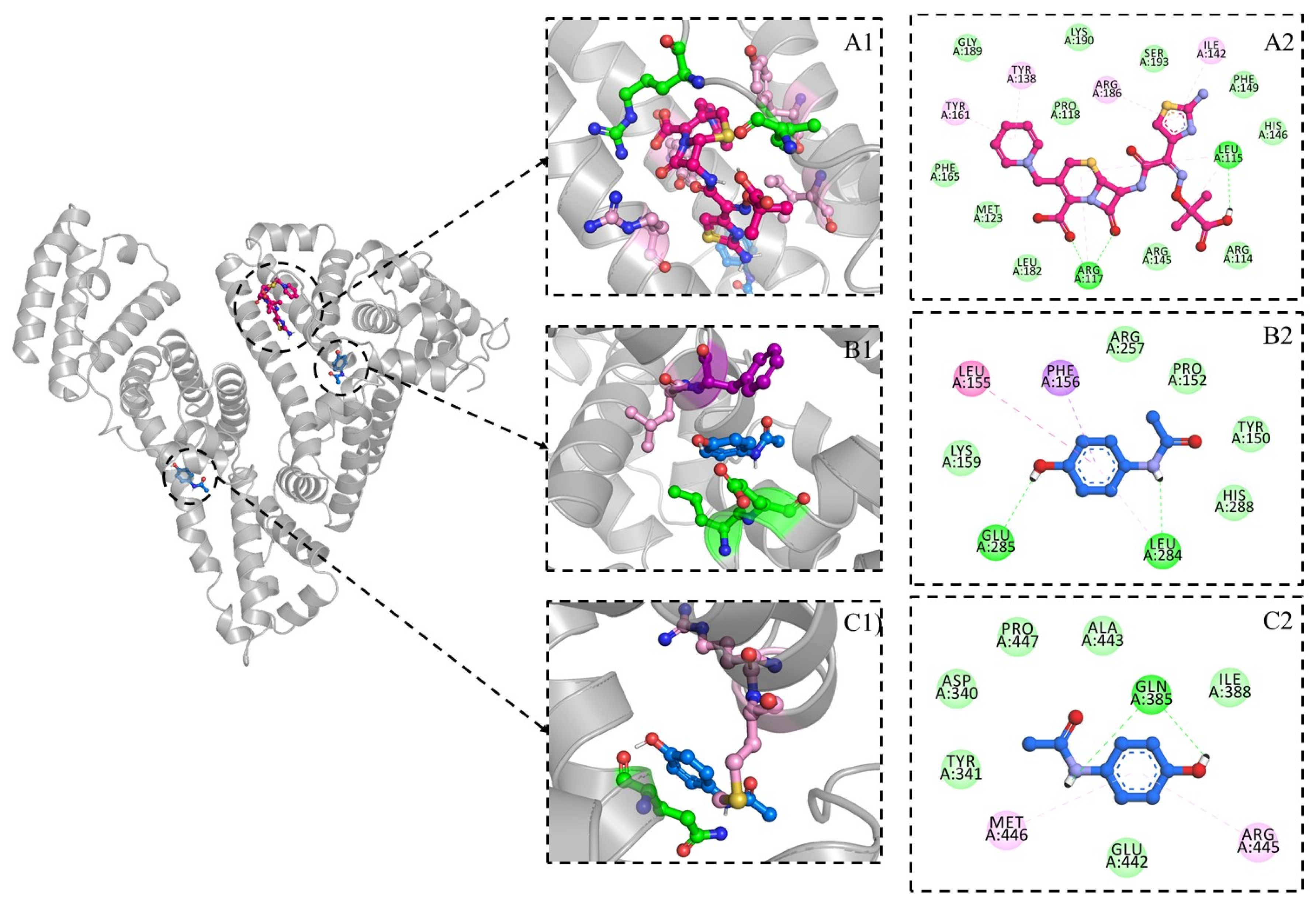

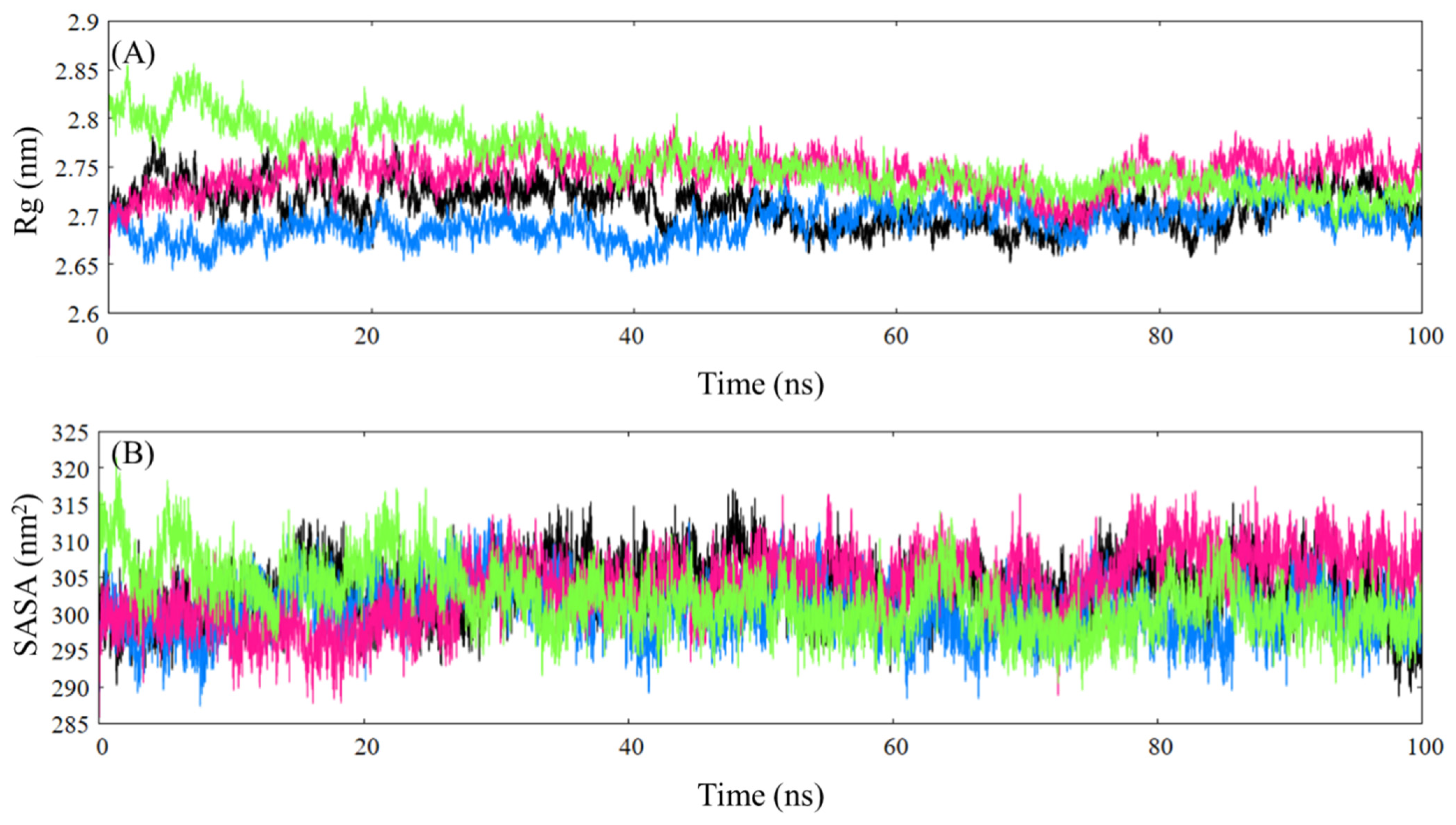


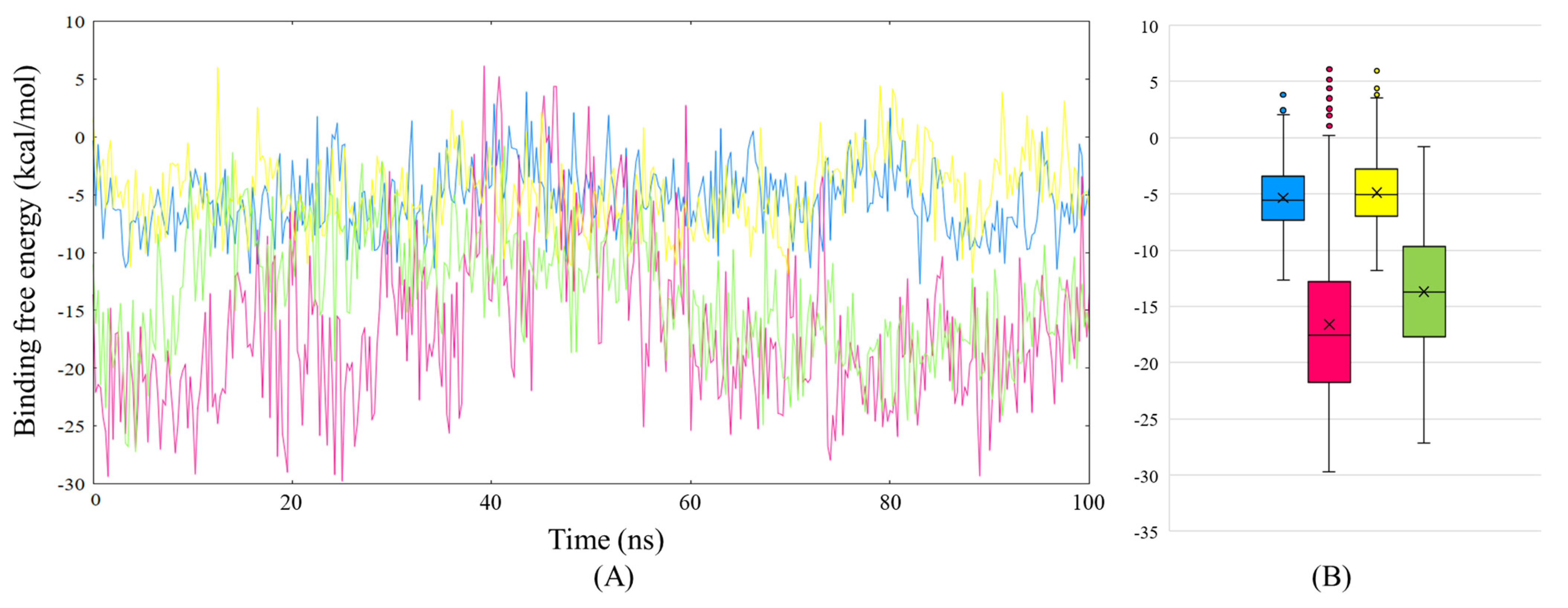
| Temperature (°C) | Quenching Parameters | Binding Parameters | Thermodynamic Parameters | |||||
|---|---|---|---|---|---|---|---|---|
| KSV (M–1) | R2 | n | Kb (M–1) | R2 | ΔG (kJ mol−1) | ΔH (kJ mol−1) | ΔS (J mol−1 K−1) | |
| 25 | 2.3 × 103 | 0.9957 | 0.96 | 1.7 × 103 | 0.9966 | −18.4 | 49.5 | 227.8 |
| 35 | 2.6 × 103 | 0.9942 | 1.01 | 3.0 × 103 | 0.9944 | −20.7 | ||
| 45 | 3.2 × 103 | 0.9967 | 1.09 | 6.1 × 103 | 0.9992 | −23.0 | ||
| Site Marker | KSV (M–1) | Kb (M–1) |
|---|---|---|
| Warfarin | 1.7 × 103 | 1.5 × 103 |
| Ibuprofen | 2.3 × 103 | 2.6 × 103 |
| Hemin | 1.3 × 103 | 0.4 × 103 |
| [Paracetamol] (µM) | KSV (M–1) | Kb (M–1) |
|---|---|---|
| 50 | 2.2 × 103 | 1.4 × 103 |
| 100 | 1.8 × 103 | 0.45 × 103 |
| 150 | 1.7 × 103 | 0.40 × 103 |
| 250 | 1.6 × 103 | 0.30 × 103 |
| 500 | 1.3 × 103 | 0.25 × 103 |
| S\No. | Ligands ID | Binding Affinity (kcal/mol) | HB | D (Å) | Pi-SR | D (Å) | vdWISR |
|---|---|---|---|---|---|---|---|
| 1 | Ceftazidime | −8.02 | Leu115 Arg117 | 2.25 2.71 2.94 | Leu115 Arg117 Tyr138 Ile142 Tyr161 Tyr138 | 4.62 4.84 4.47 4.33 5.08 4.13 4.33 | Arg114, Pro118, Met123, Arg145, His146, Phe149, Phe165, Leu182, Gly189, Lys190, Ser193 |
| 2 | Paracetamol | −5.23 | Leu284 Glu285 | 2.35 2.32 | Leu155 Phe156 Leu284 | 5.01 3.75 4.65 | Tyr150, Pro152, Lys159, Arg257, His288 |
| 3 | Ceftazidime with paracetamol-HSA complex | −9.62 | Gln385 | 2.22 2.25 | Arg445 Met446 | 4.84 5.46 | Asp340, Tyr341, Ile388, Glu442, Ala443, Pro447 |
| System | Structure | Coil | Bend | Turn | α-Helix | 5-Helix | 3-Helix |
|---|---|---|---|---|---|---|---|
| HSA | 78 | 14 | 7 | 8 | 70 | 0 | 1 |
| Paracetamol–HSA | 78 | 13 | 6 | 8 | 71 | 0 | 2 |
| Ceftazidime–HSA | 78 | 14 | 7 | 8 | 69 | 0 | 1 |
| Paracetamol–ceftazidime–HSA | 78 | 13 | 7 | 8 | 70 | 0 | 2 |
| System | Van der Waals Energy (kcal/mol) | Electrostatic Energy (kcal/mol) | Polar Solvation Energy (kcal/mol) | SASA Energy (kcal/mol) | Binding Free Energy (kcal/mol) |
|---|---|---|---|---|---|
| HSA–Paracetamol | −18.97 ± 2.00 | −12.61 ± 2.85 | 28.66 ± 5.00 | −2.41 ± 0.17 | −5.34 ± 2.92 |
| HSA–ceftazidime | −38.49 ± 8.07 | −38.18 ± 14.99 | 65.13 ± 18.46 | −5.06 ± 0.55 | −16.48 ± 6.95 |
| HSA–paracetamol–ceftazidime | |||||
| (i) Paracetamol | −19.27 ± 1.99 | −4.62 ± 2.31 | −4.62 ± 2.31 | 2.69 ± 0.16 | −4.87 ± 2.82 |
| (ii) Ceftazidime | −43.08 ± 4.81 | −31.04 ± 11.58 | 66.22 ± 14.21 | −5.71 ± 0.33 | −13.68 ± 5.15 |
Disclaimer/Publisher’s Note: The statements, opinions and data contained in all publications are solely those of the individual author(s) and contributor(s) and not of MDPI and/or the editor(s). MDPI and/or the editor(s) disclaim responsibility for any injury to people or property resulting from any ideas, methods, instructions or products referred to in the content. |
© 2023 by the authors. Licensee MDPI, Basel, Switzerland. This article is an open access article distributed under the terms and conditions of the Creative Commons Attribution (CC BY) license (https://creativecommons.org/licenses/by/4.0/).
Share and Cite
Sajid Ali, M.; Singh, E.; Muthukumaran, J.; Al-Lohedan, H.A. Non-Steroidal Anti-Inflammatory Drug Effect on the Binding of Plasma Protein with Antibiotic Drug Ceftazidime: Spectroscopic and In Silico Investigation. Int. J. Mol. Sci. 2023, 24, 14811. https://doi.org/10.3390/ijms241914811
Sajid Ali M, Singh E, Muthukumaran J, Al-Lohedan HA. Non-Steroidal Anti-Inflammatory Drug Effect on the Binding of Plasma Protein with Antibiotic Drug Ceftazidime: Spectroscopic and In Silico Investigation. International Journal of Molecular Sciences. 2023; 24(19):14811. https://doi.org/10.3390/ijms241914811
Chicago/Turabian StyleSajid Ali, Mohd, Ekampreet Singh, Jayaraman Muthukumaran, and Hamad A. Al-Lohedan. 2023. "Non-Steroidal Anti-Inflammatory Drug Effect on the Binding of Plasma Protein with Antibiotic Drug Ceftazidime: Spectroscopic and In Silico Investigation" International Journal of Molecular Sciences 24, no. 19: 14811. https://doi.org/10.3390/ijms241914811
APA StyleSajid Ali, M., Singh, E., Muthukumaran, J., & Al-Lohedan, H. A. (2023). Non-Steroidal Anti-Inflammatory Drug Effect on the Binding of Plasma Protein with Antibiotic Drug Ceftazidime: Spectroscopic and In Silico Investigation. International Journal of Molecular Sciences, 24(19), 14811. https://doi.org/10.3390/ijms241914811







